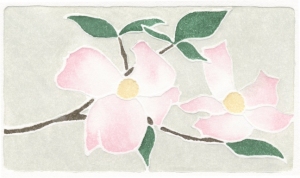| |
 View larger
image
View larger
image |
| |
 |
| |
Dogwood Blossoms
by Dan Hardison
white-line woodblock print
3" x 5 1/4" |
| |
|
 |
uring
the early days as an art colony in Provincetown, Massachusetts,
artists normally chose to leave during the harsh winter months. But
during the winter of 1915/16, a group of six artists decided to
remain in Provincetown and concentrate on woodblock
printmaking. The group shared ideas and experiences in both
traditional black and white woodblock printing and in Japanese color
woodblock printing. Impatient with the technique of color woodblock
printing that required a separate carved block for each color, B.J.O.
Nordfelt developed a method of carving a single block from which all
the colors could be printed. The result became know as the
white‑line woodblock print or Provincetown print.
Nordfelt introduced his method to the group and they continued to
develop the technique through the winter. The following summer the
group held exhibitions to display the new work that had been created
during the winter months. Interest in the new printing technique grew, and
in 1918 one of the first American print societies was formed – the
Provincetown Printers.
The creation of a white‑line woodblock print begins with a simple
outline drawing of an image on a block of wood. Grooves are then carved in
the wood to represent the lines of the drawing. Each area of color
is separated by a groove.
A sheet of paper is attached to the edge of the block to maintain
registration during printing. Colors are painted on the block using watercolor
paint. The paper is laid over the block and rubbed with the back of
a spoon or burnisher to transfer the image. Each color is printed
individually while working through small areas of the block. The resulting image on the paper will have an embossed
white line separating each area of color – thus its name.
The process makes it virtually impossible to create two prints
exactly alike. These original printmakers chose to make their
editions open‑ended in number. The image may have been the same, but
the colors would vary within the edition.
The best-known artist to work in this field was Blanche Lazzell who
continued to produce and teach the white‑line woodblock print until
her death in 1956. Lazzell used the technique to produce some of the
first abstract prints created in the United States.
The technique continues today on Cape Cod with artists such as
Ruth Hogan, Kathi Smith, and Bill Evaul. The white‑line woodblock
print appears both primitive and modern – the printing technique a
combination of craft and art form. |

